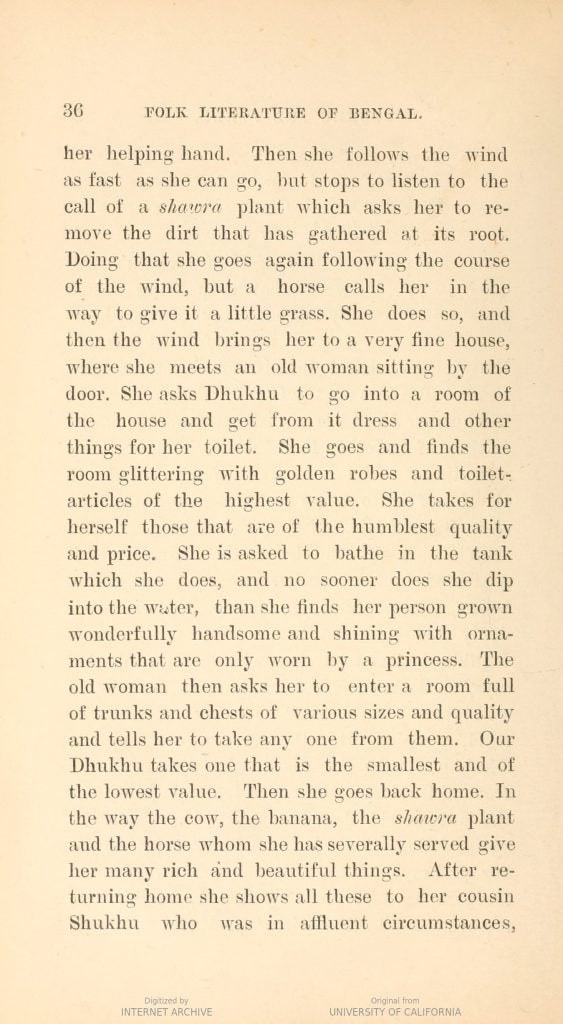Introduction
Growing up, my grandfather would always tell me stories about “mirchibai” and “haldibai”, jackals and foxes, alligators and monkeys, lions and stones, and countless more folktales. Every night after I came home from school, I would rush to his room to hear more of the stories he had to tell. The rich tales that my grandfather would tell me have entertained and enlightened countless generations which are worshipped around the Indian subcontinent, especially because of how they often define shared values in the community. That is why I chose to explore South Asian folklore this semester in HathiTrust.
My Example
I picked this page from the collection “Folk Literature of Bengal” (linked) because it talks about the shawra plant, which is incredibly important in folk tales from Southern Asia, especially Bengal and Bangladesh. After doing some research, I learned that the shawra plant is one of the very few trees which has a direct connection with ghosts in children’s ghost stories. According to the stories female ghosts use to live on the shawra plants at night, and lots of people in villages nearby used to be scared to pass by this tree during the nighttime.
Connection to Sawyer Collection Title
Baital Pachisi connects to the example that I picked because of its connection to superstition and folklore. Additionally, there are two known versions of Batali-Pachisi, which are similar to the Bengali household tales that I picked because there are a lot of versions of the same tale. In fact, there are two versions of the Baital stories. One was featured in popular children’s magazines and another was present in a popular TV show in the eighties. Each story involves superstitious rituals and areas such as grim forests, spooky graveyards, and skeletons — which have haunted children for several years!
Sawyer Seminar Learnings
Something I learned in the Sawyer Seminar that relates to what I’ve been exploring with South Asian Folktales and Household stories was the portion about Anti-Caste literature in Marathi, with some English mixed into it. There is always a mix of Colonial English with the native language such as Bengali or Hindi. In comparative literature seminars, it is important to note that the English translation is not exactly translation. It involves multilingualism in ways that are incredibly important and which ended to be part of the archives that we access. Our professor, Christi Merrill, is the one who touches on this during th
Additionally, I really enjoyed learning from Heather Christenson during the seminar. Something that struck me is that despite digitization, the aggregate HathiTrust collection is uneven and incomplete and different kinds of gaps do exist in categories such as language, subject, geographic, cultural, content, and quality. Although we generally have high quality in HathiTrust, these problems do exist and we should be cognizant of this when going through translated works.
Connection to Classmate’s Blog Post
Arabic Love Poems Throughout Time
Screencast
In this screencast, I have highlighted the keyword “story” and “tale”. Panchatantra stories. I chose this one because Panchatantra is the most frequently translated literary product of India, and these stories are among the most widely known in the world. Panchatantra stories also have many names in many cultures. There is a version of Panchatantra in nearly every major language of India so these tales spread far and wide. I also learned a bit about Theodor Benfey, who was a pioneer in the field of comparative literature.
A Category that Connects My Work to Others
A category that connects my work to others in the class is “community values”. Each of the stories in South Asian folklore has a moral at the end of the story that tends to define the values of the community. For example, if a child misbehaves, then his or her parents may bring up a folktale to teach the child a lesson so that the child does not do the same thing again. Community values are often defined by the tales passed along from generation to generation. These community values can also be found in the post by Abschmitt about Chinese folklore, as the values of the Chinese community are defined by ancient tales as well. The community values also apply to the post by ciheanyi about Arabic Love Poems Over Time. Imr-El-Kais, a poet that she talks about has had an enormous cultural impact. As a pre-Islamic poet, he has been a source of literary and national inspiration for many years and therefore defines several aspects of the community.
Tags




You must be logged in to post a comment.